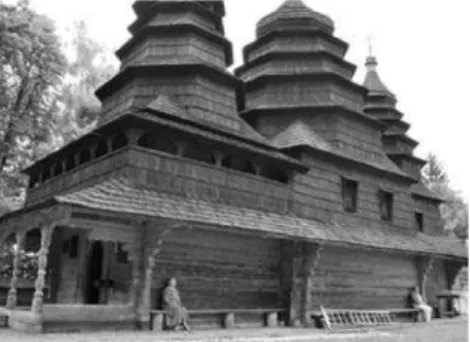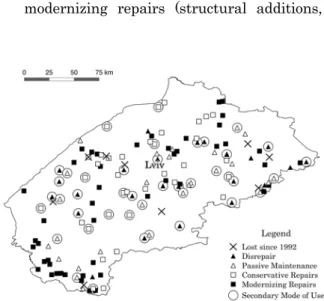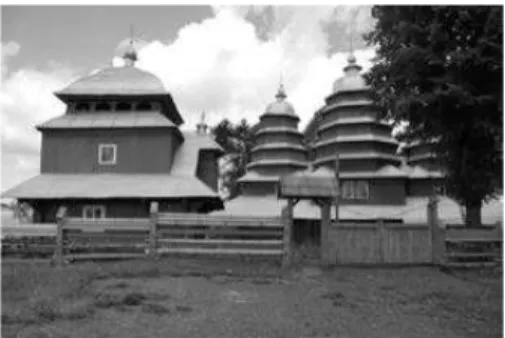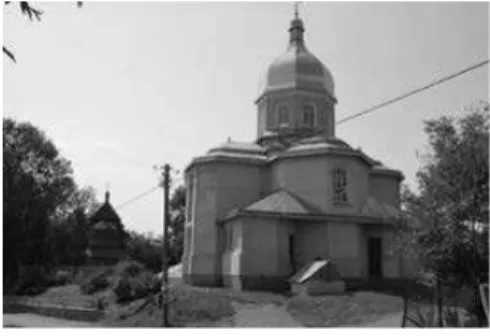ウ
ナ 歴 史 的 木 造 教 会 の 保 存 に お け る
テ ー ジ
ロ ー チ
Living Heritage Approach to the Conservation of Historical Wooden Churches in Ukraine
GD V a
1.Introduction
At the heart of this study – historical wooden churches, unique representatives of the Orthodox ecclesiastic architecture built in log-house construction technique (fig.1), preserved in big numbers across the territory of Ukraine (fig.2). It is evident that resource constraint heritage protection system in Ukraine is able to provide protection to only a few wooden churches of big historical or artistic importance. Meanwhile, as a legal successor of the Ukrainian Soviet Socialistic Republic (USSR), Ukraine had endorsed the designation records of more than 400 historical wooden churches, listed as Heritage of National Importance. However, the conditions of conservation practice in Sovereign Ukraine had changed drastically following the proclamation of the religious freedom and the separation of religion and state. Previously nationalized and non-functioning churches were officially returned to the property of religious communities. Driven by the desire to reconnect with the faith of the ancestors, recouping for the decades of the religious stagnation, new owners enthusiastically engaged in church building and reconstruction activities, either illegally changing the appearance of heritage churches, or abandoning
them for the newer and bigger venues of worshiping.
These practices evoke a public concern with the fate of the National heritage, calling for a strategic change to more effective conservation practices.
2.Research Design (1) Theoretical Perspective
Any strategic change needs a change of perspective. In this study the research problem is viewed from a perspective of one the latest theoretical developments in heritage studies - a Living Heritage Approach (LHA). LHA was initially introduced by ICCROM on the basis of its previous theoretical framework of Integrated Territorial and Urban Conservation (ITUC) and was further developed by such theorists as Poulios and Wijesuria. In brief, LHA is applied to heritage sites that are continuously used in their original function and have strong connections to local communities. Its main strategy is to prioritize core communities’ values, and concentrate on intangible, living aspects of heritage.
Taking this approach defines the focus of this study: on communities’ interaction with heritage, and the following research questions: 1) What are the current practices of maintenance and use of heritage wooden churches in property of religious
2238 306
8 3
Figure 2 Numbers of preserved historical wooden churches in different regions of Ukraine
communities? 2) Why those practices vary across the population? 3) How the existing heritage policies influence those practices? 4) How and to what extent the LHA can be applied to the conservation of historical wooden churches in Ukraine?
(3) Methodology
Due to the nature of the research questions, this study will combine architectural survey with social methods of inquiry. The funneling case study approach will unravel from the analysis of the socio-cultural background, through the quantitative survey of the visual and documentary data on the regional level, to the single ethnographic case studies.
3. Structure and Findings (1) Socio-Cultural Background
The background analysis can be summed up to the allocation of the two distinct socio-cultural processes in modern Ukraine that impact the fait of historical wooden churches. One is the movement of religious believers to return to their roots and re-connect with the faith of their ancestors after the decades of faith prohibition in Soviet Union. Another is the process of the identity search of the young nation that boost up public attention to National heritage and creates rather romantic expectations towards the conservation practice.
Probably, the most essential outcome of this chapter derives from the overview of the current Ukrainian legislation on heritage and the legal organization of religion-state relationships. It showed that the two legislative themes are not fully compatible. The modern Ukraine’s separation of religion from the state, and liberal policies towards the organization and administration of religious communities of all kinds inevitably imperil the enforcement of the Soviet-time top-down heritage legislation.
(2) Survey of Historical Wooden Churches in Lviv Oblast’, Ukraine
In this chapter, I approach some of the proposed research questions from a quantitative perspective. The purpose of this faze of research is to uncover general tendencies and patterns in community-based maintenance and use of heritage wooden churches, to explore the possible influencing factors, and to test the effects of the present heritage protection policies. To achieve these goals, I employed a range of statistical tools provided by the SPSS software, such as crosstabulation analysis with chi-square test of statistical significance, correlation analysis with Piersons r and phi tests of statistical significance, principal component factor analysis and binomial logistic regression.
First of all, through the visual analysis of the current state of the 140 heritage wooden churches of Lviv Oblast’ and the data about the most resent repairs, I identified the following maintenance patterns performed by the corresponding religious communities:
• disrepair (no repair action with visible signs of decay) – 24 properties;
• passive maintenance in a good state (no repair action with no visible signs of decay) – 30 properties;
• modernizing repairs (structural additions,
Figure 3.Observed patterns of maintenance and use of sampled wooden churches located on the map of Lviv
reshaping of cupolas, renewal of the external cladding with the use of modern materials) – 50 properties;
• conservative repairs (renewal of the external cladding with the use of historically appropriate materials, or scientific restorations) – 36 properties.
I also observed that churches had a different mode of use. Majority, 97 of them were the only churches of the parish and were used as regular venues for religious services. However, in 43 cases, communities had newer churches as their main venues, and heritage churches were used as secondary venues, opening for special holidays or family occasions.
Figure 3 shows the observed patterns of maintenance and use, located on the map of Lviv Oblast’, including the designated wooden churches that were lost during the years of Independent Ukraine. Certain tendencies could be picked up from the mapping outcome. For instance, the peculiarity of the South-West region of Lviv Oblast, where most of the wooden churches are modernized and used in primary function. The absence of modernizing repairs and the prevalence of disrepair in secondarily used wooden churches confirms the hypothesis of the major role of church function in maintenance practices.
Next, the correlation analysis with a range of external factors helped to identify the dependency of the church maintenance practices from the size and the type of settlements where they were located. Religious communities in the more
populous or urban settlements showed the higher rates of adherence to the conservative repairs and treatments. This correlation was interpreted as the influence of the public control over the actions of the communities and greater legal visibility of their actions.
Combining the factors of church function and public control, I divided the sample of heritage wooden churches into three conceptual groups: Group I – churches of high public control and high user value (located in urban settlements over 1000 citizens, or having high touristic value). Those churches are significantly less likely to be modernized and more likely to be conservatively repaired.
Group II – churches of low public control but high user value (primarily used churches in rural areas). It is evident that they are less likely to decay, much more likely to be modernized and less likely to be conservatively repaired.
Group III – churches with low public control and low user value (secondarily used churches in rural areas). They are more likely to decay, but highly unlikely to be modernized (graph 1).
This classification reflects different circumstances that create very different maintenance outcomes and therefore require different managerial actions.
Final stage of the quantitative analysis involved the comparison of the two samples of wooden churches in Lviv Oblast’, built before 20th century – non-designated churches and those, designated as the heritage of National importance. Only
Graph 2 Distribution of the observed maintenance patterns between designated and non-designated churches Graph 1 Distribution of the observed maintenance
insignificant difference was observed in the patterns of modernizing and conservative repairs, which proved little to no effect of the current heritage protection policies. Moreover, designated wooden churches displayed higher rates of abandonment and more severe signs of decay, which can be interpreted as the discouraging effect of heritage policies on the community-based custodianship (graph 2).
(3) Case Studies
Matkiv case, representative of Group I, depicts the peculiar transition of a rural, small community wooden church into a high public profile World heritage site.
Matkiv village is located in the mountainous South-West region. In this area, wood is still a major material for construction, and traditional building techniques are commonly used. Every village has a functioning wooden church. This, and the remoteness of the region from the administrative centers explain the prevalence of the modernizing maintenance practices, displayed in Figure 3.
The 19th century Church of St. Dmytro (fig. 4) was recently inscribed on the World Heritage list. It stands out among the neighbors being the least modified and decorated. Even before it became the World Heritage site, the priest of the parish exercised his authority to prevent many attempts of modernizing repairs.
The Nomination file sets plans to restore the original appearance of the church – clad roofs with wooden shingles and uncover the logs of the
first tier. However, the local community opposes to these changes, valuing the present look of the church, - with sheet metal roofs and bright interior oil paintings. The joint Steering Committee of the site, featuring community representatives, is working to find a balance of all stakeholders’ interests.
Vidniv case, representative of Group II, depicts a primary used 18th century heritage wooden church currently undergoing modernizing repairs (fig. 5).
In early 2000s, walls of the church were covered with low quality wooden panels, roofs - with modern titanium nitride (TiN) cladding, igniting an outrage in heritage activists’ circles. In 2015 – another repair is in progress. Local craftsmen are replacing wooden panels that already decayed and damaged underlying log structure.
Interviews with local residents and craftsmen showed that community is interested in maintaining their church in good state but not at the costs that are required according to the present heritage legislation. Doing the repairs in secret they often lack valuable consultation of heritage specialists.
Klits’ko case, classified into Group II, is a rare example of the primary used rural church that was scientifically restored by the local community but is very likely to decay in the near future. Klitsko village has 2 religious communities, - Greek Catholic and Orthodox - that are currently sharing one 17th century wooden church. The
Figure 4 Wooden Church of St. Dmytro (1838), Matkiv village (July, 2015)
Figure 5 Wooden Church of Assumption of Blessed Virgin Marry (1738), Matkiv village
bigger and more prosperous Orthodox community is currently building a new stone church at the same location (fig. 6).
The scientific restoration took place in 2007, led by a famous civil activist, village expat. Sadly, in 2008 the church was damaged by fire, and had not been repaired since.
It is quite possible that the one-time conservative intervention has actually left the church in more vulnerable condition, as the small and aging Greek Catholic community of the village has no means of sustaining the high-maintenance wooden cladding of the church. Also, this case demonstrates how the construction of the new church weakens maintenance of the heritage church in a small community.
Loni case, representative of Group III, describes the community-based efforts to restore the 18th century wooden church that have fallen into disuse and decayed and the repairs are currently in progress (fig. 7).
Loni village is located off road and has no gas
communications. It is a place where only old people leave and in winter even they prefer to stay with their children in cities. Greek Catholic Community of the village uses a new stone church built in 1994. The old wooden church has fallen into decay, but villagers still come to pray there privately using a church’s porch for the altar. Evidently, the church has big importance for the local community as a place of religious wonderwork, memorable historical events, personal nostalgia and even symbolic self-identification. Therefore, in 2010, the expats of the village in Lviv city and abroad initiated a fundraising campaign to rescue the church from destruction and to restore its historical appearance. When community used private funds, there was a problem with contractors who did not follow the restoration project and worsened the state of the church. After that, regional government allocated budget money and organized proper surveillance.
This case sheds light on the motives and difficulties of community-based restoration campaigns. Most importantly, it shows that heritage can serve as a social platform that brings residents and expats together, creating other various social benefits.
4. Conclusions
(1) Research Outcomes
This research showed the variety of socio-cultural circumstances, in which the community-based maintenance of the historical wooden churches takes place. It provides the evidence that different maintenance practices are affected by the factors of public control and user value, and require accordingly diversified managerial actions. While current heritage policies work well in the areas of high public control, - in urban settlements and famous tourist destinations, - biggest share of wooden churches is scattered in remote rural areas, where monitoring and law enforcement hardly reach. Wooden churches used as main venues of worshiping attract a lot of private funding and volunteer work as a part of religious Figure 6 Wooden Church of Assumbtion of
Blessed Virgin Marry (1604) and the new church construction Klits’ko village (August,
2015)
Figure 7 Wooden Church of the Blessed Virgin Marry (1724), Loni village (July,
service of the associated communities. However, unable to meet the high conservation standards and bureaucratic requirements prescribed by legislation, communities conduct the repairs secretly and illegally, often unknowingly damaging the properties with improper treatments.
Historical wooden churches that had lost their primary function in rural communities are in high danger of disrepair and decay. At the same time, their secondary function includes a commemorative element that makes a scientific restoration desirable, but not affordable to local communities.
(2) Proposals
My proposal to the conservation of historical wooden churches in Ukraine is to apply Living Heritage Approach to the churches classified into Group II in this thesis, - those located in the areas with low level of public control and used as main venues for worshiping. The strategies should include the lifting of restrictions on material change and treatments of wooden churches with the provision of free scientific-based consultations and educational activities among the community members. The findings of this study suggest that not only such approach will support the living dimensions of heritage, but it also will be beneficial to material preservation, as it has potential to reduce the occurrence of the most damaging practices – unprofessional treatments and withholding of repairs.
As to the rest of the churches, for the Group I wooden churches I advocate the application of the classical Value-Based Approach to conservation with transparently defined mutual responsibilities of the government and property owners. Lastly, for the Group III – special programs on capacity building among the local communities are advised, with the strategy to stimulate community-based initiatives, develop touristic activity and gradually include them into Group I management group on voluntarily basis.
(3) Significance
The findings are significant for the theory and practice of historical wooden church preservation in Ukraine, since for the first time the problem was approached from the core communities’ point of view. My hope is that this research will serve as a base for future studies in both, Living Heritage theory and Ukrainian wooden churches. Methodology developed in this study can be applied to other living religious sites around the globe.
Selected Bibliography
1) Bogdanova, A., Uekita Y., Community-Based Maintenance of Historical Wooden Churches in Lviv Region, Ukraine, Journal of Asian Architecture and Building Engineering 14, no. 3, pp.499-504, September 2005
2) Bolotskih, N. et al., Actual Restoration and Preservation Problems of the Ukrainian Wooden Churches, Rescuing the Hidden European Churches Heritage, ed. by G. Tampone, Semplici, M., pp.183-192, 2006
3) Buxton, D., The Wooden Churches of Eastern Europe, 1981 4) Gnatyuk, L., The Role of Religious Communities for the
Development of the World Heritage Properties, Heritage Conservation Regional Network Journal, no. 1, 2012 5) Nozaki, T., ウ イ の木造 シア正教教会堂: その 1.
エプ 川流域の木造 シア正教教会堂の特徴 (建築歴史・意
匠)", 学術講演梗概集, p55-56, 2001
6) Poulios, I., Moving beyond a values-based approach to heritage conservation, Conservation and Management of
Archaeological Sites 12, no. 2, pp170-185, 2010
7) Schneider, H., Community Involvement in the Preservation of World Heritage Sites: The Case of the Ukrainian Carpathian Wooden Churches, 2013
8) UNESCO. “Wooden Tserkvas of the Carpathian Region in Poland and Ukraine.” Nomination file for the inscription on
World Heritage list. 2011.




